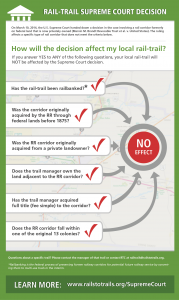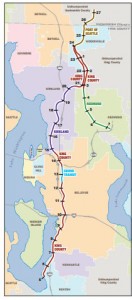Most rails-to-trails projects in the US will not be affected by this week’s Supreme Court ruling, according to the Rails-to-Trails Conservancy.
That assessment follows a US Supreme Court ruling (Marvin M. Brandt Revocable Trust vs the United States) that the federal government could not turn a particular abandoned railroad right-of-way in Wyoming into a bicycle trail. That ruling apparently applies only to a very limited set of circumstances.
The Rails-to-Trails Conservancy has set out to clarify the issues raised by the Supreme Court ruling. In “The Supreme Court Decision: How Does It Affect Rail-Trails?”, the nonprofit says the ruling’s reach is fairly narrow.
“The vast majority of current and planned rail-trails will not be affected,” writes Kevin Mills, senior VP of policy and trail development for Rails-to-Trails Conservancy.
Here’s the breakdown on rail-trails that are not affected by the ruling if any of these conditions are met:
- The rail corridor is “railbanked.”
- The rail corridor was originally acquired by the railroad by a federally granted right-of-way (FGROW) through federal lands before 1875.
- The railroad originally acquired the corridor from a private land owner.
- The trail manager owns the land adjacent to the rail corridor.
- The trail manager owns full title (fee simple) to the corridor.
- The railroad corridor falls within the original 13 colonies.
Eastside Rail Corridor
For instance, here in King County, the former BNSF railroad line known as the Eastside Rail Corridor was “railbanked” in 2009. The 42-mile railroad runs from Renton to Woodinville, with a spur line into Redmond.
The federal railbanking program, established in the early 1980s, enabled railroad lines that had been proposed for abandonment to be preserved through interim conversion to trail use. The right-of-way remains as a trail until such time that the railroad might need the corridor again.
As Rails-to-Trails explains, “Some railroad rights-of-way contain easements that revert back to adjacent landowners when an abandonment is consummated. However, if a line is railbanked, the corridor is treated as if it had not been abandoned. As a result, the integrity of the corridor is maintained, and any reversions that could break it up into small pieces are prevented.”
The trail group estimates that 4,400 miles of rail corridors in 33 states have been saved by the railbanking program.
Other trails
While the “vast majority” of current and proposed trails won’t be affected, according to the nonprofit, the only way to be sure is to check with trail managers on a case-by-case basis.
And how about the future of the rails-to-trails program. The lone dissenter in the ruling, Justice Sonia Sotamayor, wrote that “lawsuits challenging the conversion of former rails to recreational trails alone may well cost American taxpayers hundreds of millions of dollars, will the government have to pay off landowners for use of abandoned railroad rights-of-way, potentially spending tens of millions of dollars?”
Mills writes that the ruling could serve to prompt more lawsuits from landowners adjacent to federal granted rights-of-way.
During the Supreme Court hearing, the Justice Department lawyers said they had no idea how many acres could be involved.



Recent Comments